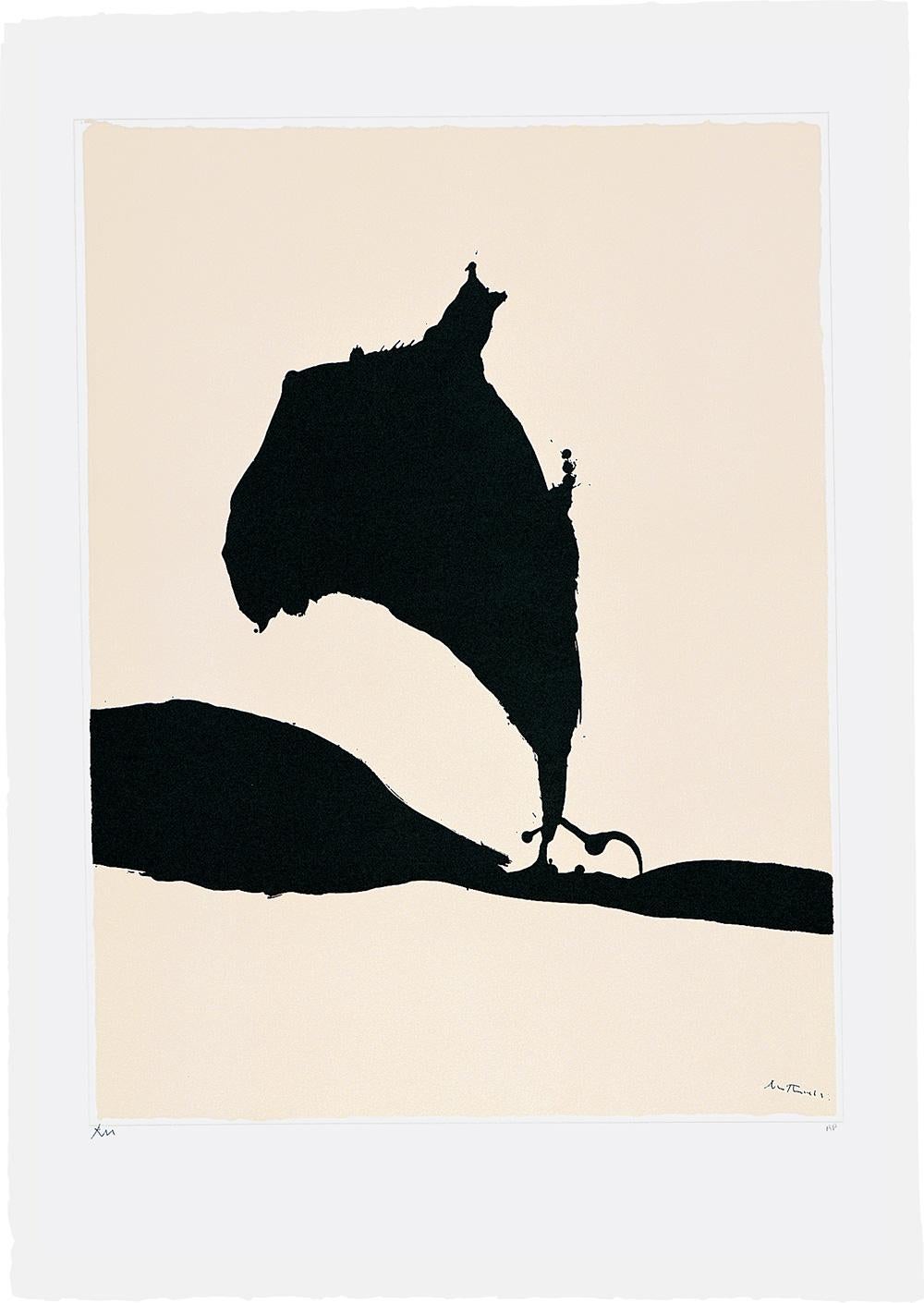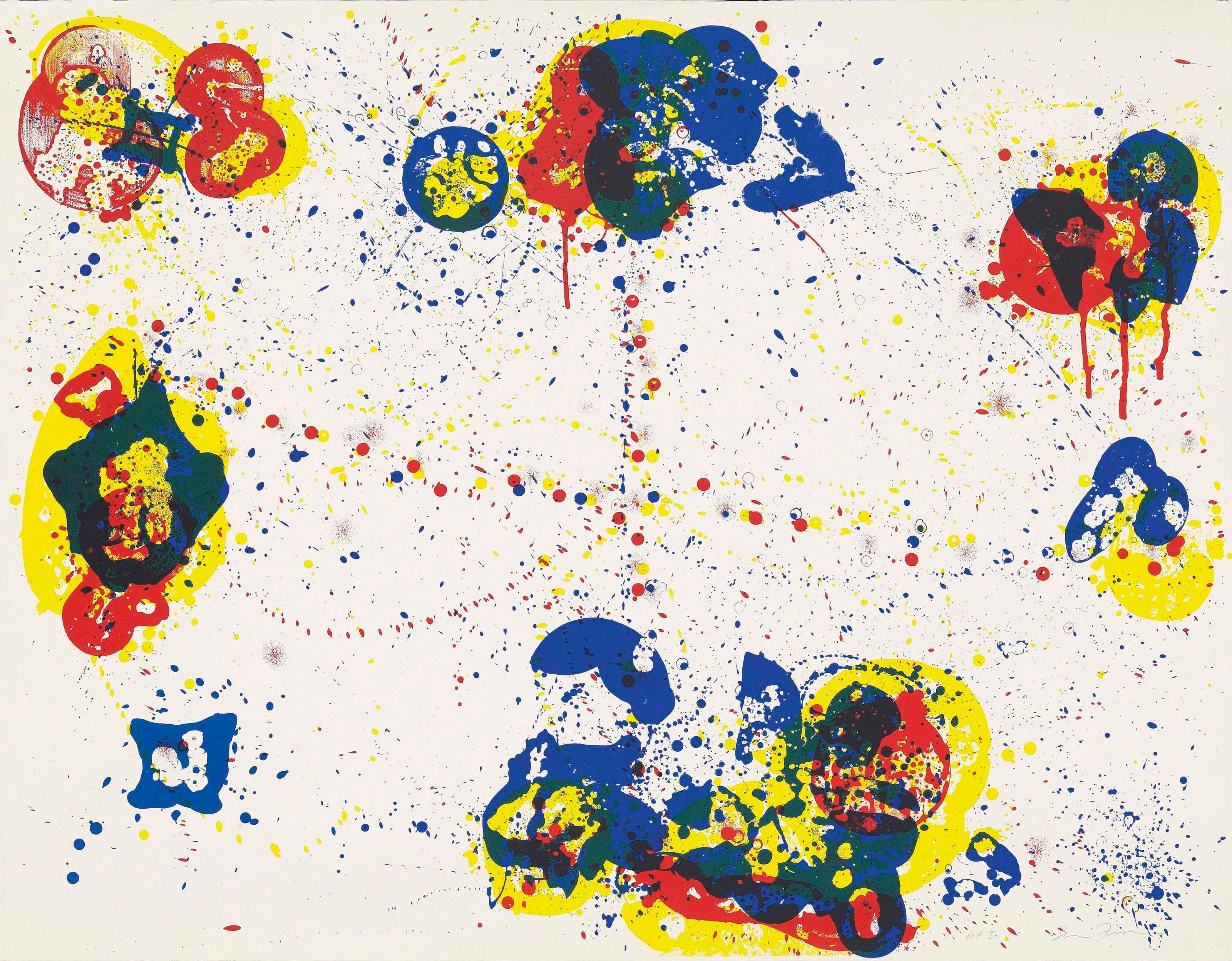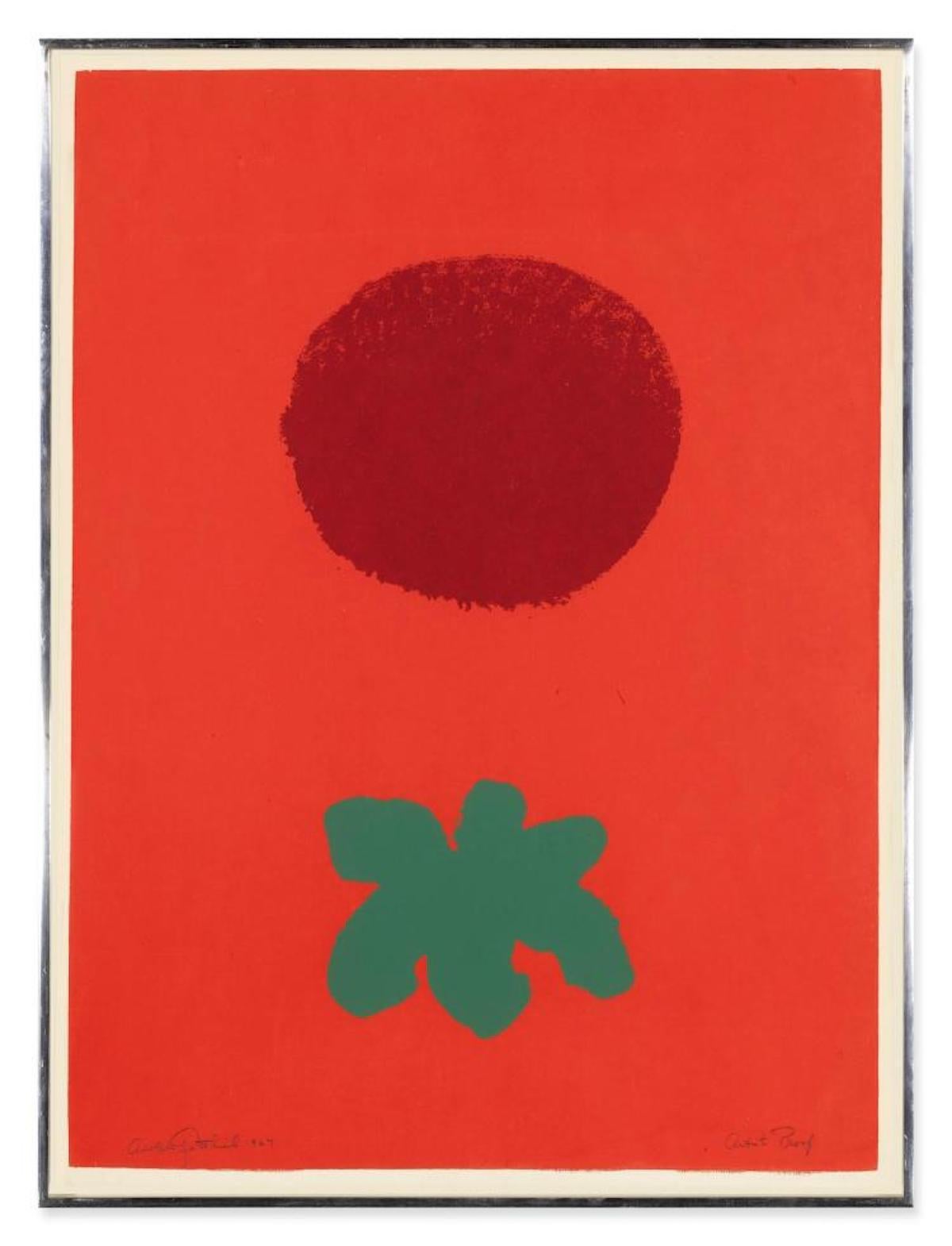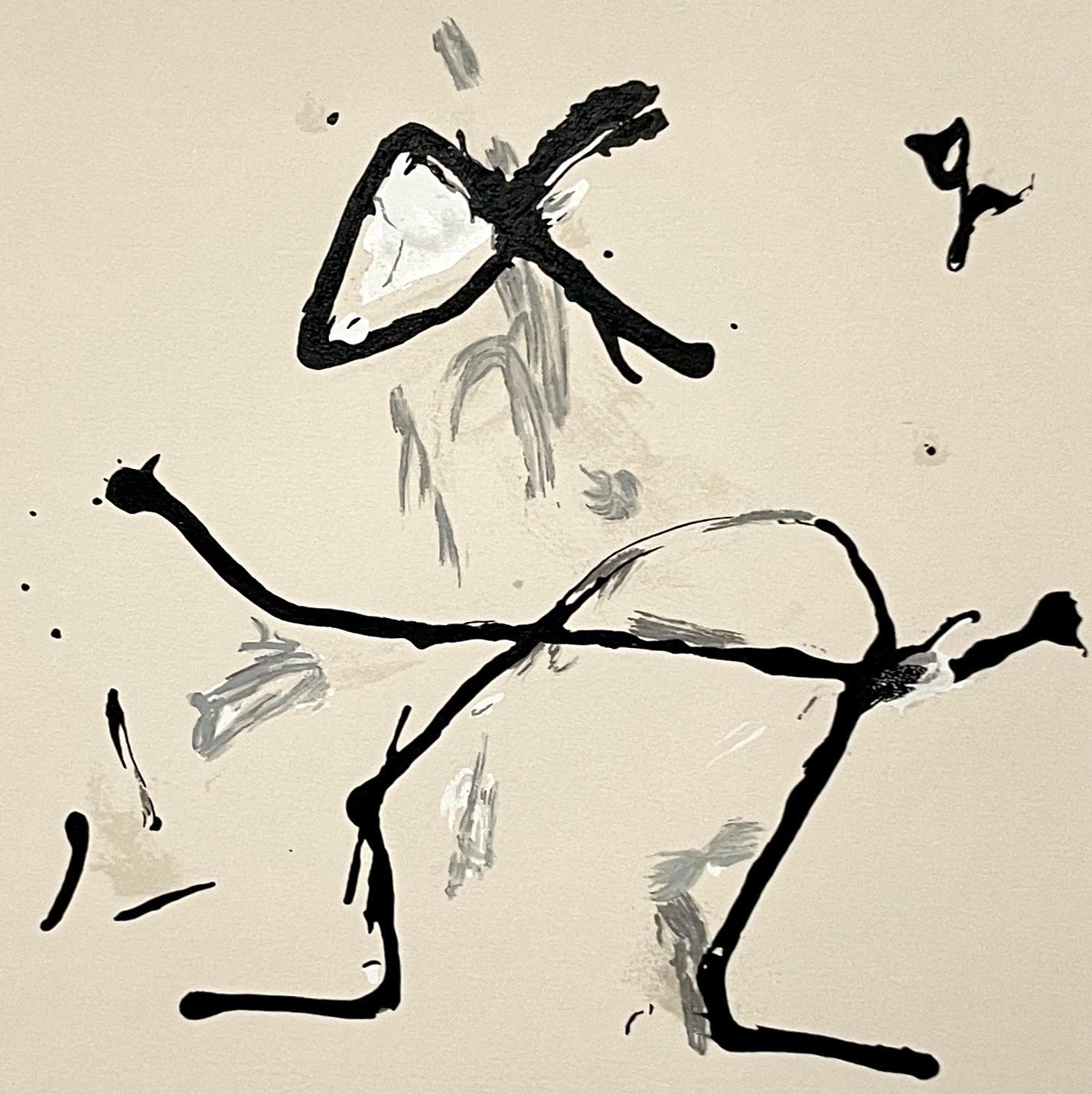Items Similar to Giuseppe Capogrossi Iconic Comb Design "Superficie 324" Serigrafia
Want more images or videos?
Request additional images or videos from the seller
1 of 12
Giuseppe CapogrossiGiuseppe Capogrossi Iconic Comb Design "Superficie 324" Serigrafia1988
1988
About the Item
"Superficie 324" is a 1988 screen print (serigraph) of a 1959 painting by Capogrossi. This is one of his famous "comb" or "fork" works that he perfected in the 1950s and continued to create for the remainder of his life. The blocks of primary red and yellow colors give a bright, joyful feel and contrast to the strong bold black that was Capogrossi's consistent color for the "combs". With no allegorical, psychological, or symbolic meanings, these structural elements could be assembled and connected in countless variations. Intricate and insistent, Capogrossi's signs determined the construction of the pictorial surface. This piece is identified along one side: Giuseppe Capogrossi By SIAE 1988 Silvio Zamorani Editor Via Saccarelli, 9 10144 Torino Italy Tel. (39)(11) 4730554 Progetto Grafico (Graphic Project): Studio Walter Benjamin. Serigrafia (Screen Print): BISI Torino.
Capogrossi was born in Rome. After obtaining a degree in law in 1923–1924, he decided to study painting with Felice Carena at Accademia di Belle Arti di Roma. In 1927 Capogrossi embarked on a formative trip to Paris together with fellow artists and acquaintances Fausto Pirandello, Corrado Cagli and Emanuele Cavalli. They worked in a figurative style characterized by pale and ethereal tones, which endowed their compositions with a mysterious, almost magical aura. The three artists were among the loose association of painters that came to be known as Scuola Romana (Roman School). In 1933 they collaborated on the "Manifesto del primordialismo plastico" (Manifesto of plastic primordialism), in which they discussed the presence of the archaic in the contemporary world. From the mid-1930s, Capogrossi adopted a darker palette, and between 1945 and 1948 his figurative tonal painting gave way to an increasingly abstract geometric style.
A decisive shift in Capogrossi's career took place in 1949, when he developed a vocabulary of irregular comb- or fork-shaped designs. Similar to mysterious lists or sequences, his paintings were immediate in their appeal yet remained hard to decode, a quality he shared with Art Informel practitioners. These abstract comb-sign paintings, usually known simply as Surfaces (Superficies), were begun in 1949 and first exhibited at the Galleria del secolo, Rome, in 1950. Soon becoming the hallmark of Capogrossi's style, the comb sign dominated his oeuvre until the end of his career.
In 1951, Capogrossi joined Mario Ballocco, Alberto Burri, and Ettore Colla in showing work at Aurora 41, Rome, an occasion that marked the debut of the group Origine (Origin, 1950–51). Primarily concerned with the promotion of abstract art, the group reacted against mainstream realist practices and advocated a simplified language meant to return art to its origins. The following year, Capogrossi joined the Movimento spaziale (Spatial movement, 1947–60), initiated by Lucio Fontana in Milan. Readily embracing the many changes affecting the country in the postwar era, especially scientific progress, the group advocated for a new spatial art that acknowledged recent inventions such as television and neon lighting.
Capogrossi's singularity was recognized both in Italy and abroad, and he took part in group exhibitions at Galerie Nina Dausset, Paris (1951); Guggenheim Museum (1953); Venice Biennale (1954, 1962); Documenta, Kassel, West Germany (1955, 1959); Carnegie International, Pittsburgh (1958, 1961); and Tate Gallery, London (1964). Capogrossi has also been the subject of numerous solo shows at institutions including the Institute of Contemporary Arts, London (1957); Leo Castelli Gallery, New York (1958); Palais des beaux-arts, Brussels (1959); and Galleria L'attico, Rome (1962). Capogrossi died on October 9, 1972, in Rome. Two years later the Galleria nazionale d'arte moderna, Rome, organized his first major posthumous retrospective.
- Creator:Giuseppe Capogrossi
- Creation Year:1988
- Dimensions:Height: 40.25 in (102.24 cm)Width: 55.25 in (140.34 cm)
- Medium:
- Movement & Style:
- Period:
- Condition:
- Gallery Location:Detroit, MI
- Reference Number:1stDibs: LU1286111560142
About the Seller
5.0
Vetted Seller
These experienced sellers undergo a comprehensive evaluation by our team of in-house experts.
Established in 2014
1stDibs seller since 2019
96 sales on 1stDibs
Typical response time: 5 hours
- ShippingRetrieving quote...Ships From: Detroit, MI
- Return PolicyA return for this item may be initiated within 14 days of delivery.
More From This SellerView All
- Helen Frankenthaler What Red Lines Can Do Series, Screen PrintBy Helen FrankenthalerLocated in Detroit, MIONE WEEK ONLY SALE "Untitled" lithograph from Frakenthaler's What Red Lines Can Do Series. Signed and dated, with the numbers 55/9/75 on the lower front right. Color screen print on white arches handmade cold press paper. Helen Frankenthaler was born on December 12, 1928 in New York City, the daughter of a New York Supreme Court judge and a family of Jewish immigrants from Germany who emphasized culture and intellectual pursuits and continue to be active to this day such as through nephew, the artist and photographer Clifford...Category
1970s Abstract Expressionist Abstract Prints
MaterialsLithograph
- Joyce T. Nagel Collagraph "Earthcore" Signed Dated Ltd EdLocated in Detroit, MI"Earthcore" is an abstract of a familiar image ... a view of earth sliced in half usually as an explanation of the many layers of spaceship earth. This print is more than its title. It is rich in its depth of color and texture. Upon close inspection there is much activity on the surface which continually adds to its visual complexity. The name given to this print process is “Collagraph” It is made by glueing different materials to cardboard and creating a kind of collage. During the inking process the ink will rub off surfaces that are smooth or higher and stay on surfaces that hold more ink, at edge and at lower points thus creating the image. To protect the plate through the printing process it’s sealed with one or more layers of shellac. A collagraph plate is quite sensitive and will be deformed by the pressure of the printing press. Joyce Tilley Nagel...Category
1960s Abstract Expressionist Abstract Prints
MaterialsPaper, Ink
- Joyce T. Nagel Monoprint Abstract "Dropout" Signed DatedLocated in Detroit, MI"Dropout" is one of the monoprints that Joyce Nagel so enjoyed creating. This monoprint is a one-off abstract print. The arrangement of shapes and colors p...Category
1980s Abstract Expressionist Abstract Prints
MaterialsPaper, Ink
- Piero Dorazio Lithograph Abstract Geometric Quadrilateral PolygonBy Piero DorazioLocated in Detroit, MIThe work is a Lithograph, not numbered, but signed and dated by the artist, Piero Dorazio. The print has an intense color field with a strong linear element being composed of quadril...Category
1970s Abstract Expressionist Abstract Prints
MaterialsLithograph
- Robert Natkin Abstract Lithograph Signed NumberedBy Robert NatkinLocated in Detroit, MISALE ONE WEEK ONLY Soft pastel colors in floating smudges lay between and around lyrical abstract geometric and organic forms giving a diaphanous color and shape harmony to the work...Category
1990s Abstract Expressionist Abstract Prints
MaterialsLithograph
- Jean Dubuffet Lithograph Art Brut "I. Traces grotesques"By Jean DubuffetLocated in Detroit, MISALE ONE WEEK ONLY "I. Traces grotesques" is an Artist’s Proof Lithograph. “Proofs” are either pulled or printed, and the artist has the option to work out the color and quality issues as they come out of the process. The only real difference between the two is the restricted quantity of prints bearing the AP designation and not the quality of the print. This lithograph is signed and titled by the artist, Jean Dubuffet, which indicates his complete satisfaction with the print. It is from 1958 and a perfect example of his style, “Art Brut.” His idealistic approach to aesthetics embraced what is called “low art”, art by non-academically trained artists. It is sometimes referred to as “outsider art.” He did study briefly at the Academie Julian, Paris, but eventually followed his own aesthetics which eschewed traditional standard of beauty in favor of what he believed to be a more authentic and humanistic approach to image-making. This lithograph expresses the beauty he found in the meandering spontaneous black line. Jean Dubuffet began painting at the age of seventeen and studied briefly at the Academie Julian, Paris. He painted off and on for the next 20 years. It was not until 1942 in the midst of WWII in France that he began the work which has distinguished him as an outstanding innovator in postwar Europe. It is said of his work that “he looked to the margins of the everyday – the art of prisoners, psychics, the uneducated, and the institutionalized – to liberate his own creativity and coining the term ‘Art Brut’.” Art Brut is a French term that translates as ‘raw art’, to describe art such as graffiti or naïve art which is made outside the academic tradition of fine art. His paintings from the early forties in brightly colored oils were soon followed by works in which he employed such unorthodox materials as cement, plaster, tar and asphalt-scraped, craved and cut and drawn upon with a rudimentary, spontaneous line. Dubuffet worked in France and exhibited from the early forties on. He was included in the 1946 Pierre Matisse...Category
1950s Abstract Abstract Prints
MaterialsLithograph
You May Also Like
- Africa Suite: Africa 9By Robert MotherwellLocated in London, GBThe original studies from the 'Africa Suite' were a group of ten works selected from a series of ink-on-paper drawings from the same year. The large autom...Category
1970s Abstract Expressionist Abstract Prints
MaterialsScreen
- Africa Suite: Africa 7By Robert MotherwellLocated in London, GBThe original studies from the 'Africa Suite' were a group of ten works selected from a series of ink-on-paper drawings from the same year. The large autom...Category
1970s Abstract Expressionist Abstract Prints
MaterialsScreen
- Web (SFS-136)By Sam FrancisLocated in New York, NYScreenprint on wove paper Edition of 50 Published by Gemini G.E.L., Los Angeles Signed and numbered in pencil with studio blindstampCategory
Late 20th Century Abstract Expressionist Abstract Prints
MaterialsScreen
- February (abstract print from Domberger series)By Karl Fred DahmenLocated in New York, NYFrom the "Edition Domberger 1980" Signed and numbered with publisher embossingCategory
20th Century Abstract Expressionist Abstract Prints
MaterialsScreen
- Red GroundBy Adolph GottliebLocated in New York, NYScreenprint in colors, on wove paper Sheet: 30 3/8 x 22 1/2 in. (77.2 x 57.2 cm) Edition of 75 Signed in pencil, dated and inscribed 'Artist Proof' on lower marginCategory
1960s Abstract Expressionist Abstract Prints
MaterialsScreen
- Emil Schumacher Limited Edition Serigraph Terraraph Print Abstract Art InformelLocated in Surfside, FLHeavily textured abstract print in a serigraph and terragraph technique. It has a raised texture to the surface, A beautiful piece. This listing is for the one print, the cover justification sheet and the photograph are just included for provenance. This is from the limited edition of 100. Hand signed and numbered on colophon page. (They are not signed and numbered on each print) Arches paper. Dimensions: 15.75 X 15.25 These have a texture that feels like a painting. Done in Jaffa Israel based on the Hebrew Bible. Jewish, Judaica interest. Emil Schumacher is among the best-known exponents of Art Informel in Germany. His painting style, which he initially developed in the 1950s under the influence of Wols, is marked by dark, brownish black or brilliant thick red colours and a graffiti like sign language that endow the pictures the expressive character of old cracked masonry. Emil Schumacher (29 August 1912 in Hagen, Westfalen – 4 October 1999 in San José, Ibiza) was a German artist and painter. He was an important representative of abstract expressionism in post-war Germany. As an 18-year-old, Emil Schumacher undertakes a four-week-long bicycle tour to Paris, France. 1932–1935: Studies graphic design at the School of Applied Arts in Dortmund intending to become a graphic designer in advertising. 1935–1939: Independent artist without participating in exhibits. He undertakes study trips by bicycle to the Netherlands and Belgium. 1939–1945: Service obligation as draftsman in an arms factory, the Akkumulatoren–Werke of Hagen. Since 1945: Immediately after end of war, new start as independent artist. 1947: First solo exhibit in the Studio für neue Kunst. Co-founder of the artist group Junger Westen. 1954: Participates in the Willem Sandberg...Category
20th Century Abstract Expressionist Abstract Prints
MaterialsScreen
Recently Viewed
View AllMore Ways To Browse
Dior 1988
Vintage Comb
Vintage Changing Screen
Vintage Tv Screen
Retro Television Screen
Red Giuseppe
Black And White Serigraph
Abstract Expressionist Serigraph
Fontana Roma
Vintage Progress Lighting
Burri Alberto
Yellow Cavalli
The Attico
1950s Neon Sign
L Shaped Screen
1950s Vintage Neon Signs
Neon 1930s
Giuseppe Capogrossi




